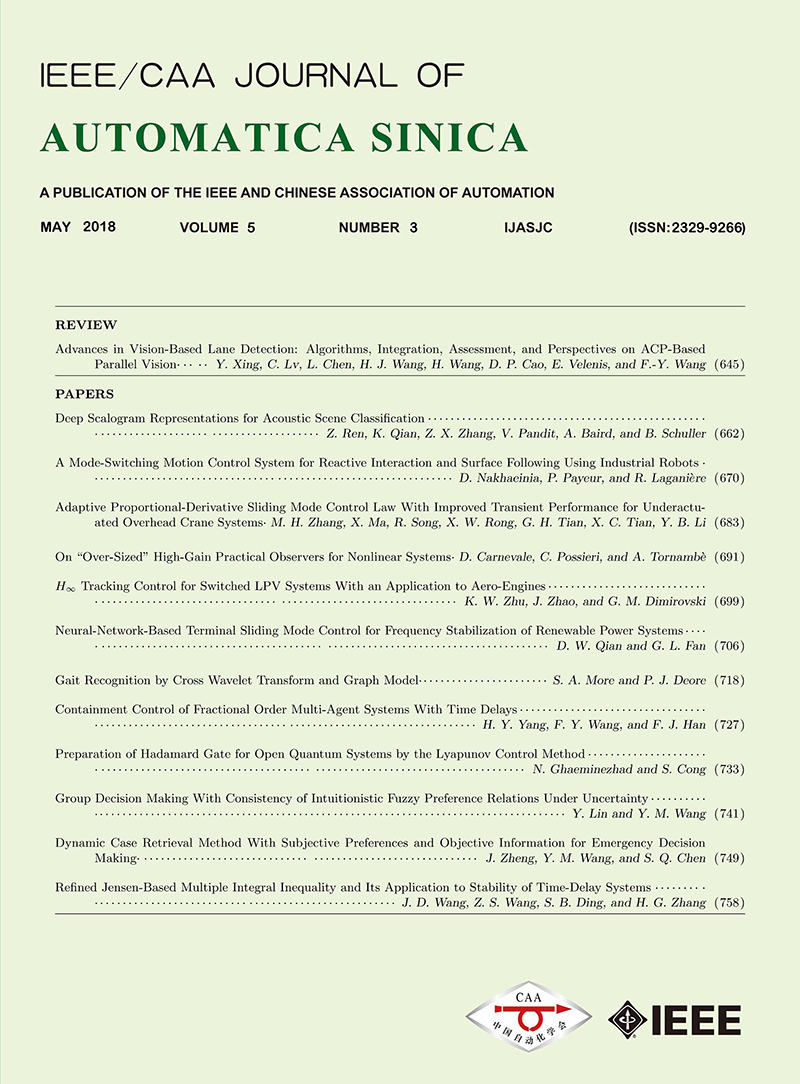 Volume 2
Issue 1
Volume 2
Issue 1
IEEE/CAA Journal of Automatica Sinica
| Citation: | Jingmei Zhang, Changyin Sun, Ruimin Zhang and Chengshan Qian, "Adaptive Sliding Mode Control for Re-entry Attitude of Near Space Hypersonic Vehicle Based on Backstepping Design," IEEE/CAA J. of Autom. Sinica, vol. 2, no. 1, pp. 94-101, 2015. |

| [1] |
He Jie, Zheng De-Zhai. Characteristics and key technology research for hypersonic vehicle. In:Proceedings of the 2012 Aerospace Science and Technology Innovation and the Yangtze River Delta Economic Transformation Development BBS. Lianyungang, China:2012. 227-231(in Chinese)
|
| [2] |
Chen Zong-Ji, Zhang Ru-Lin, Zhang Ping, Zhou Rui. Flight control, challenges and opportunities. Acta Automatica Sinica, 2013, 39(6):703-710(in Chinese)
|
| [3] |
Bao Wei-Min. Present situation and development tendency of aerospace control techniques. Acta Automatica Sinica, 2013, 39(6):697-702(in Chinese)
|
| [4] |
Sun Chang-Yin, Mu Chao-Xu, Yu Yao. Some control problems for near space hypersonic vehicles. Acta Automatica Sinica, 2013, 39(11):1901-1913(in Chinese)
|
| [5] |
Xu H J, Mirmirani M D, Ioannou P A. Adaptive sliding mode control design for a hypersonic flight vehicle. Journal of Guidance, Control, and Dynamics, 2004, 27(5):829-838
|
| [6] |
Zhang R M, Sun C Y, Zhang J M, Zhou Y J. Second order terminal sliding mode control for hypersonic vehicle in cruising flight with sliding mode disturbance observer. Journal of Control Theory and Applications, 2013, 11(2):299-305
|
| [7] |
Zhang R M, Wang L, Zhou Y L. On-line RNN compensated second order nonsingular terminal sliding mode control for hypersonic vehicle. International Journal of Intelligent Computing and Cybernetics, 2012, 5(2):186-205
|
| [8] |
Li Jing-Jing, Ren Zhang, Song Jian-Shuang. Fuzzy sliding mode control for hypersonic re-entry vehicle. Journal of Shanghai Jiaotong University, 2011, 45(2):295-300(in Chinese)
|
| [9] |
Da Costa R R, Chu Q P, Mulder J A. Reentry flight controller design using nonlinear dynamic inversion. Journal of Spacecraft and Rockets, 2003, 40(1):64-71
|
| [10] |
Du Y L, Wu Q X, Jiang C S, Xue Y L. Adaptive recurrent-functionallink- network control for hypersonic vehicles with atmospheric disturbances. Science China, 2011, 54(3):482-497
|
| [11] |
Wang P, Tang G J, Liu L H, Wu J. Nonlinear hierarchy-structured predictive control design for a generic hypersonic vehicle. Science China Technological Sciences, 2013, 56(8):2015-2036
|
| [12] |
Kanellakopoulos I, Kokotovic P V, Morse A S. Systematic design of adaptive controllers for feedback linearizable systems. IEEE Transactions on Automatic Control, 1991, 36(11):1241-1253
|
| [13] |
Koshkouei A J, Zinober A S I. Adaptive backstepping control of nonlinear systems with unmatched uncertainty. In:Proceedings of the 39th IEEE Conference on Decision and Control. Sydney, Australia:IEEE, 2000. 4765-4770
|
| [14] |
Swaroop D, Hedrick J K, Yip P P, Gerdes J C. Dynamic surface control for a class of nonlinear systems. IEEE Transactions on Automatic Control, 2000, 45(10):1893-1899
|
| [15] |
Gao D X, Sun Z Q, Du T R. Dynamic surface control for hypersonic aircraft using fuzzy logic system. In:Proceedings of the 1st IEEE International Conference on Automation and Logistics. Jinan, China:IEEE, 2007. 2314-2319
|
| [16] |
Utkin V. Variable structure systems with sliding modes. IEEE Transactions on Automatic Control, 1977, 22(2):212-222
|
| [17] |
Zhou Y X, Wu Y X, Hu Y M. Robust backstepping sliding mode control of a class of uncertain MIMO nonlinear systems. In:Proceedings of the 6th IEEE International Conference on Control and Automation. Guangzhou, China:IEEE, 2007. 1916-1921
|
| [18] |
Zhu Kai, Qi Nai-Ming, Qin Chang-Mao. Adaptive sliding mode controller design for BTT missile based on backstepping control. Journal of Astronautics, 2011, 31(3):769-773(in Chinese)
|
| [19] |
Plestan F, Shtessel Y, Bregeault V, Poznyak A. New methodologies for adaptive sliding mode control. International Journal of Control, 2010, 83(9):1907-1919
|
| [20] |
Park J, Sandberg I W. Universal approximation using radial basis function networks. Neural Computation, 1991, 3(2):246-257
|
| [21] |
Cybenko G. Approximation by superpositions of a sigmoidal function. Mathematics of Control, Signals, and Systems, 1989, 2(4):303-314
|
| [22] |
Hornik K, Stinchcombe M, White H. Multilayer feedforward networks are universal approximators. Neural Networks, 1989, 2(5):359-366
|
| [23] |
Hu Y N, Jin Y Q, Cui P Y. RBF NN-based backstepping control for strict feedback block nonlinear system and its application. Advances in Neural Networks ISNN 2004 Lecture Notes in Computer Science, 2004, 3174:129-137
|
| [24] |
Shaughnessy J D, Pinckney S Z, McMinn J D, Cruz C I, Kelley M L. Hypersonic Vehicle Simulation Model:Winged-cone Configuration, Technical Report TM-102610, NASA, USA, 1990.
|
| [25] |
Keshmiri S, Mirmirani M D. Six-DOF modeling and simulation of a generic hypersonic vehicle for conceptual design studies. Modeling and Simulation Technologies Conference and Exhibit, 2004, 1-12
|
| [26] |
Slotine J E, Li W P. Applied Nonlinear Control. Englewood Cliff, NJ:Prentice Hall, 1991. 290-292
|
| [27] |
Levant A. Higher-order sliding modes, differentiation and outputfeedback control. International Journal of Control, 2003, 76(9):924-941
|